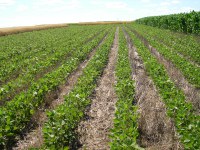Harvesting Nontraditional Crops for Hay an Option
(Click the image below to view a high-resolution image that can be downloaded)
The drought in North Dakota is impacting the yield of small-grain crops such as barley, oats, rye, triticale and wheat, leading some producers to harvest the small grains as hay.
The severe lack of moisture also has impacted this year’s hay production and many producers are seeking alternative, possibly nontraditional, sources of forage such as cattails, flax, kochia, millet varieties and soybeans.
“With limited forage on the market and high prices, it may be a better option to evaluate local hay options,” North Dakota State University Extension beef cattle specialist Zac Carlson says. “Price and quality of alternative forages will play a key role in determining whether they can be used in a given production situation.
“Potential health risks for livestock also should be evaluated,” he adds.
“As with all plants, forage quality depends primarily on the stage of maturity at the time of harvest, ability to properly dry the forage and storage after harvest,” says Janna Block, livestock systems specialist at NDSU’s Hettinger Research Extension Center. “Harvesting more mature crops will lead to greater yields but lower digestibility and protein content.”
If you are a producer considering harvesting or using nontraditional crops and forages, here are some considerations:
Cattails
In a drought, access to cattails may be feasible. When plants are harvested early in maturity, cattails can contain up to 6% crude protein (CP) and 50% total digestible nutrients (TDN). However, mature cattails have little to no feed value and may be better used for bedding.
Flax
Harvesting flax for hay is unusual; however, when harvested at the early stages of seed boll development, flax hay can contain 10% CP and has digestibility similar to grass-alfalfa hay. Once cut, drying can be difficult, so consider using a conditioner or crimper.
Flax can contain high levels of cyanogenic compounds capable of producing prussic acid (cyanide). These compounds can be elevated during a drought. Harvesting as hay, compared with grazing, reduces the risk of livestock getting cyanide poisoning.
However, to ensure you have safe and good-quality hay, sample harvested forage and submit samples to a laboratory. Be sure to call and ask if the lab staff can analyze all forms of cyanide gas or just those associated with sorghum and sudangrass hybrids.
See the NDSU publication “Cyanide Poisoning” (https://www.ag.ndsu.edu/publications/livestock/cyanide-poisoning) for more information about understanding cyanide poisoning in livestock.
Millet
Foxtail and proso millets can provide relatively good-quality hay. Millets should be harvested at the same maturity as small grains for forage - between the heading and soft dough stages of grain development. However, drying can be difficult for some millet varieties, so consider using a conditioner or crimper to assist with the drying process.
Blend millet hay with other sources of hay to avoid the potential for scours. Avoid feeding millet to horses because it may cause lameness and affect kidney function. Nitrate toxicity also is a potential risk with millet.
Kochia
Kochia should be harvested at about 20 to 26 inches in height and before flowering for forage quality similar to alfalfa hay. Forage quality of kochia can vary considerably (6% to 22% CP).
Kochia hay has a laxative effect and has been reported to cause photosensitivity. Kochia is high in oxalates, which bind with calcium in the blood, leading to hypocalcemia.
Gradually increase the amount of kochia hay cows consume for several weeks and avoid feeding kochia hay to lactating cows. Additional supplementation of limestone is cost-effective and may help reduce the risk of oxalate poisoning. Kochia also is a nitrate accumulator, so be sure to submit samples for analysis prior to feeding.
Soybeans
Soybeans can be utilized for hay or silage. Soybean silage can be mixed with corn or sorghum silage to create good-quality forage. When harvested for hay, soybeans may contain CP and TDN similar to alfalfa hay.
The best time to harvest soybeans is during early pod development, when pods are less than an inch long. Soybean hay can contain a lot of stems, and livestock will sort out and refuse to eat the stems. Grinding and blending with other forages should improve consumption.
Take precautions to protect soybean hay from moisture. Unlike grass hay, moisture can penetrate the bale more easily and cause spoilage. As with other alternative forages, soybeans can accumulate nitrates, so be sure to collect and submit samples for nitrate analysis.
See the NDSU publication “Nitrate Poisoning of Livestock” (https://www.ag.ndsu.edu/publications/livestock/nitrate-poisoning-of-livestock) for more information about elevated concentrations of nitrates in feedstuffs.
Conducting a nutrient analysis is important to best plan for when to utilize alternative forages and other feeds.
“Make sure to analyze for potentially toxic components such as nitrate and cyanide if applicable,” Carlson says. “In many cases, blending nontraditional forages with more common forages can help minimize potential toxicity risks.
“To maximize the use of alternative and nontraditional forages, develop a strategic feeding plan,” he advises. “Target feeding cows lower-quality feed after weaning, when they no longer are in lactation. Spare higher-quality forages for later in gestation or early lactation.”
For more information on harvesting nontraditional crops or plants for hay this year, contact an Extension agent in your county.
NDSU Agriculture Communication - July 26, 2021
Source: Zac Carlson, 701-231-1884, zachary.e.carlson@ndsu.edu
Source: Janna Block, 701-567-4323, janna.block@ndsu.edu
Editor: Ellen Crawford, 701-231-5391, ellen.crawford@ndsu.edu


